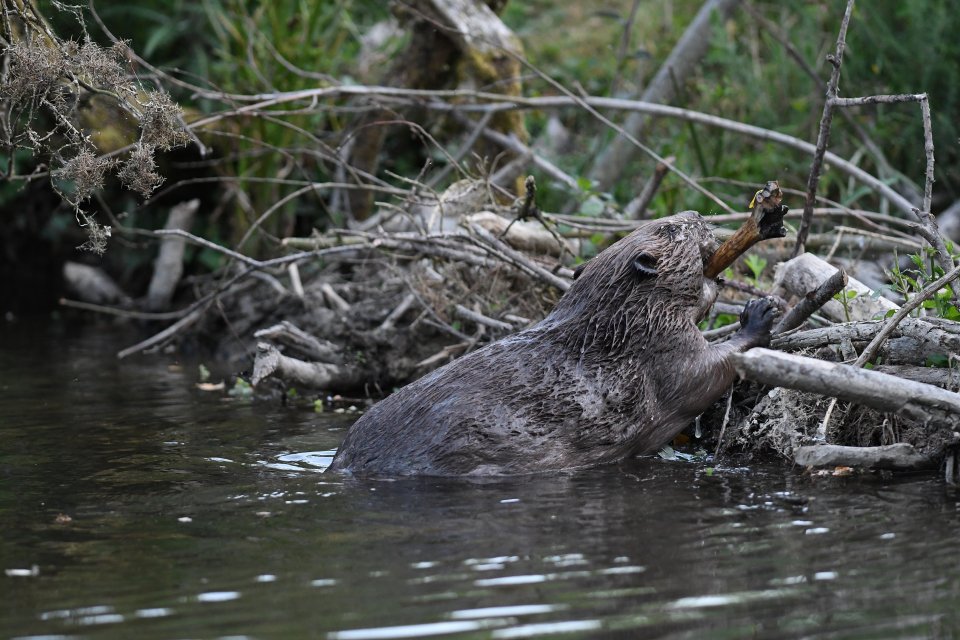
The Devon Enclosed Beaver Project is located in West Devon within the catchment of the River Tamar in a low intensity agricultural landscape. The River Otter Beaver Trial (ROBT) is located in East Devon.
The Cornwall project is located on one of the three tributaries of the Tresillian River entering Ladock, the area is dominated by lowland farmland, particularly intensive grassland for livestock.
To reintroduce beavers into the wild and to assess their potential to provide natural flood management, water quality improvements and improved biodiversity.
In 2011 a male and female beaver were introduced into a three-hectare (seven acre) fenced enclosure in the Tamar headwaters in Devon. The amount of water entering, being stored and leaving the site has been monitored through weirs and dipwells. Since their reintroduction, the beavers have created a new wetland, constructing 13 ponds, holding up to one million litres of additional water. Research has shown that this new wetland created by the beavers has a flood attenuation effect which slows the flow of the water and reduces flood peaks. The wetland has also led to significant improvements in water quality, reducing sediment and nitrogen yields downstream. The water storage and slow release effect has resulted in an elevated base flow from the site even in periods of drought.
The River Otter Beaver Trial in East Devon was started in 2015, after two families of wild beavers from an unknown source were captured from the River Otter, examined and released back to the river as part of a five-year licensed trial. This is the first licensed release of beavers into the wild in England and a comprehensive Monitoring Plan is in place overseen by a Science and Evidence Forum, chaired by Professor Richard Brazier at the University of Exeter. A Beaver Management Strategy Framework is also being produced to outline how beavers can be managed in the wild at the end of the Trial.
A further fenced trial has recently begun in Cornwall, where a two hectare (five acre) area of plantation woodland was fenced off to create a beaver enclosure along a stream near the village of Ladock. An adult breeding pair of beavers were released into a pond on site in 2017. Prof Brazier’s team are monitoring the impacts of the beavers on water levels and has had equipment on site for over a year before the beavers were released so that comparisons can be made. Cornwall Wildlife Trust, with help from volunteer specialists, are also monitoring biodiversity of the site such as habitats, amphibians, bats and fish. The beavers have so far constructed 5 or more dams at the site. There have been a significant flow attenuation impacts, especially during periods of heavy rainfall. Water used to take less than 15 minutes to travel through the site and now, thanks to the beavers, takes over an hour.
|
Potential impacts/ benefits |
||||
|
Challenges addressed |
Enhancing sustainable urbanisation |
Restoring ecosystems and their functions |
Developing climate change mitigation |
Developing climate change adaptation |
|
Water Management |
· Improve water quality |
· Improve connectivity and functionality of green and blue infrastructure |
· Flood peak reduction · Increase water shortage |
|
|
Climate resilience |
· Carbon sequestration and storage |
· Baseflow elevation during drought periods |
||
|
Public Health and Wellbeing |
· Increase well-being |
· Increase cultural richness and biodiversity |
||
- Flood peak reduction
- Increase infiltration / Water storage
- Carbon sequestration and storage
- Improve connectivity and functionality of green and blue infrastructures
- Increased cultural richness and biodiversity
- Improve water quality
- Increase well-being
Deep water should always be present on a release site and release into the wild currently requires a licence from the relevant national authority (Natural England in this case).
Beavers are highly effective at creating and managing wetland habitats and can be a good tool for water resource management, particularly natural flood management.
Reintroduction of this species should be considered at a catchment scale rather than at a site scale, ideally.
Keeping beavers in large enclosures for a number of years can be achieved with high-specification purpose-built fencing.
The Devon Enclosed Beaver Project site is owned by John and Elaine Morgan. Additional funding has come from Natural England through Higher Level Stewardship (HLS). The initial fencing and other infrastructure was funded by Viridor Credits Environmental Company and the Truell Charitable Foundation. In 2012, Westland Countryside Stewards began funding the project allowing the University of Exeter to carry out detailed research work.
Funding for the River Otter Beaver Trial comes from Devon Wildlife Trust, the Royal Society for Wildlife Trusts, Peter de Haan Charitable Trust, The Tale Valley Trust, Garfield Weston Foundation, NERC, the Wellcome Trust, the University of Exeter and donations from the public.


